The UEFA Europa League final between Atalanta BC and Bayer Leverkusen promised to be a tactical masterclass, showcasing the strategic brilliance of two of Europe’s most intriguing teams.
This tactical analysis will delve into the key elements that have determined the outcome of this highly anticipated clash.
Atalanta, under the experienced guidance of Gian Piero Gasperini, have demonstrated a potent mix of attacking flair and defensive solidity in their UEFA Europa League campaign.
Meanwhile, Bayer Leverkusen, led by the emerging coaching talent Xabi Alonso, have impressed with their dynamic style and tactical versatility this season.
This analysis explores the strategies and formations employed by both teams, highlighting the tactical nuances that were used in the final.
Join us as we break down the tactics, analyse the formations, and look back to the game-changers in this epic encounter.
This tactical analysis provides a comprehensive overview of what to happened when Atalanta and Bayer Leverkusen faced off in the UEFA Europa League final 2024.
Atalanta BC Vs Bayer Leverkusen Lineups
Both Atalanta BC and Bayer Leverkusen approach the UEFA Europa League final with theoretically similar formations, but their playing styles differ significantly.
Also known as La Dea, Atalanta were making their first appearance in a UEFA final.
They recently suffered a narrow 1-0 defeat to Juventus in the Coppa Italia Final.
However, Gianluca Scamacca, who was suspended for that match, returned for the Europa League final alongside Charles De Ketelaere and Ademola Lookman, with Teun Koopmeiners dropping into a deeper midfield role.
Marten de Roon and Emil Holm were unavailable, and Rafael Toloi wasn’t fully fit.
Musso – Kolasinac, Hien, Djimsiti – Ruggeri, Koopmeiners, Éderson, Zappacosta – Lookman, De Ketelaere – Scamacca
Leverkusen were riding high after securing their first Bundesliga title and aiming for a treble, with the German Cup final against Kaiserslautern still to come.
They have set a new European club record with an unbeaten streak of 51 competitive matches.
Their resilience was on display when they recovered from a 2-0 deficit to draw 2-2 with Roma in the semi-final second leg.
For the final, they continued with a False 9 strategy, leaving Victor Boniface and Patrik Schick on the bench.
The experienced Granit Xhaka would orchestrate the midfield, while Jeremie Frimpong’s speed was planned to pose a significant threat on the right flank.
Kovár – Hincapié, Tah, Tapsoba – Grimaldo, Xhaka, Palacios, Stanisic – Wirtz, Frimpong – Adli
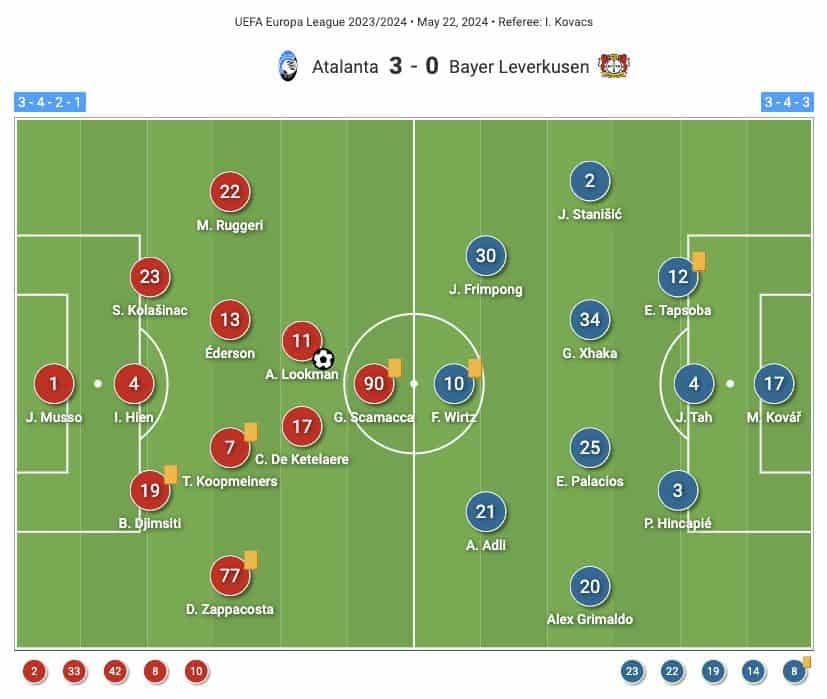
This tactical setup of two 3-4-2-1 formations promised a fascinating clash, with Atalanta’s structured yet dynamic approach facing off against Leverkusen’s high-paced, adaptable play.
Atalanta’s man-to-man approach
In the UEFA Europa League final, Atalanta BC’s man-to-man defending strategy proved to be a decisive factor in their victory over Bayer Leverkusen.
As anticipated, Atalanta mirrored Leverkusen’s formation but implemented their signature man-to-man defensive approach, aiming to create the game scenario that suited them best.
This approach significantly disrupted Leverkusen’s usual combinative style as they progressed up the field.
From the start, Atalanta pressed Leverkusen intensely.
Atalanta’s first line of defence would typically drop back to force Leverkusen to recycle possession through their centre-backs.
Once this occurred, Atalanta’s players set up in direct one-on-one matchups across the field.
This forced Leverkusen into a positional phase where stability and control were paramount, making them more predictable and easier to defend against.

Atalanta excelled at controlling Leverkusen’s passing and movement, particularly those initiated by their centre-backs.
Atalanta’s first line constantly dropped back, using their bodies to slow down Leverkusen’s runners, effectively neutralising their build-up play.
This man-to-man pressure made it simple for Atalanta to mirror Leverkusen’s movements and create a suffocating defensive environment.
The off-ball intensity of Atalanta’s defence stifled Leverkusen, leading to numerous mistakes and misplaced passes.
A clear example of this was when Palacios, under pressure, played the ball back into a congested area, where Atalanta’s players were ready to collapse onto the pivot.
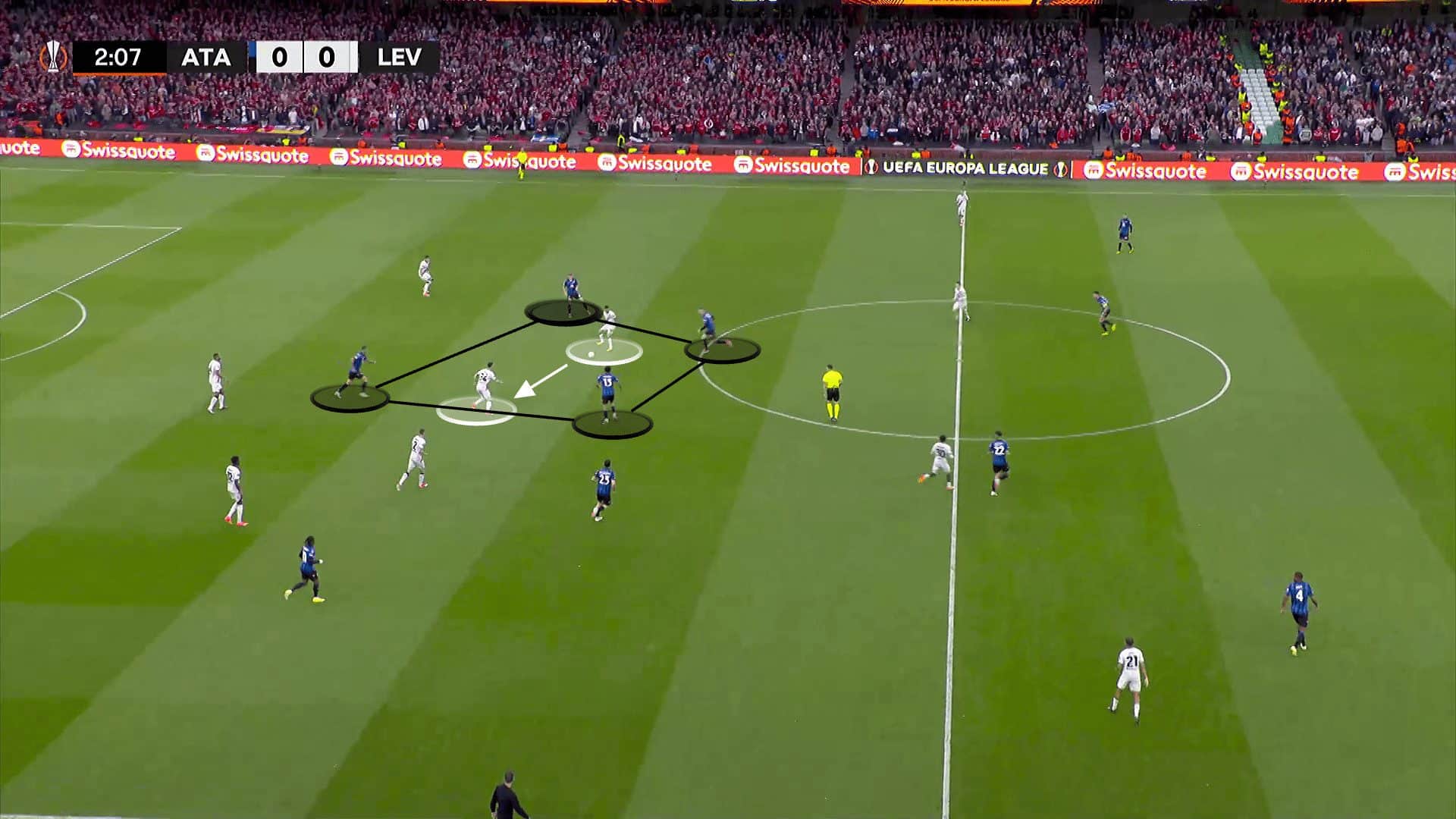
Double man-marking on key players like Wirtz, who often dropped deep to receive the ball, and Grimaldo, who was unable to exploit any space, further highlighted Leverkusen’s struggles.
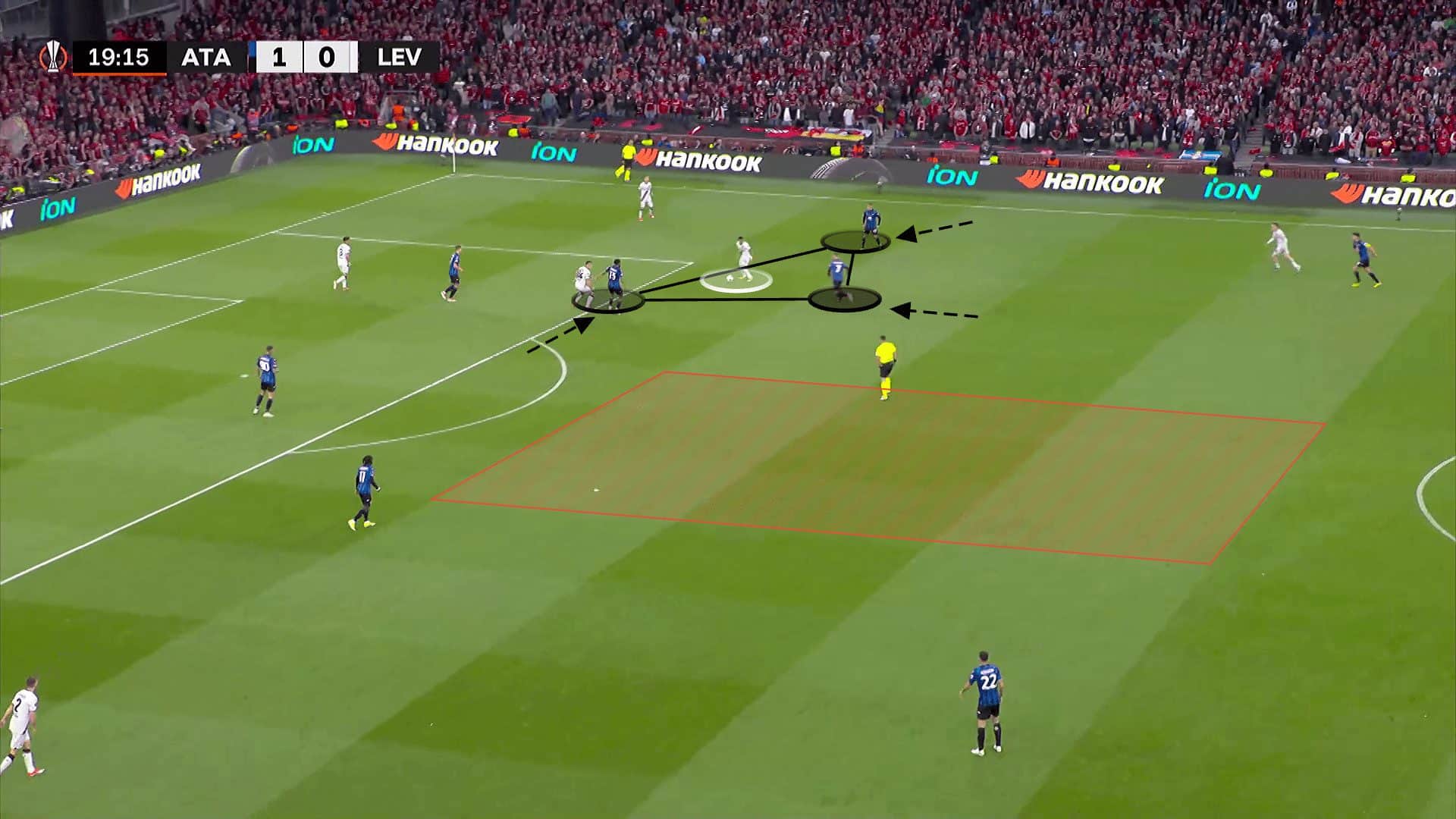
Leverkusen’s lack of an orthodox striker was a critical flaw in their game plan against Atalanta’s man-to-man press.
Without a physical presence up front to hold up the ball or run the channels, Leverkusen found it difficult to maintain possession and relieve pressure.
This lack of a focal point meant the ball often failed to stick, preventing Leverkusen from advancing up the field effectively.
This tactical oversight by Alonso proved costly, as Atalanta capitalised on their opponent’s inability to escape the press.
Leverkusen’s build-up
Bayer Leverkusen’s build-up approach in the UEFA Europa League final against Atalanta BC was an intriguing aspect of their gameplay, especially since they adopted this style at the start of the season.
Under Xabi Alonso, Leverkusen’s strategy relied heavily on controlled possession, positional play, and a more mobile front three to create spaces and opportunities.
However, the immense pressure of playing in their biggest match of the season led to a more conservative and rigid approach.
Throughout the final, Leverkusen’s players, understandably feeling the stress of the occasion, opted for less risky passes and focused on maintaining control.
This cautious strategy, while intended to prevent errors, inadvertently hampered their usual fluid and dynamic play.
Florian Wirtz, a key player in their mobile front three, often found himself neutralised by Atalanta’s physical and tactical fouls, which disrupted Leverkusen’s offensive rhythm.
From the outset, Atalanta capitalised on Leverkusen’s cautious approach.
After taking an early lead, Atalanta expertly crafted a game plan that played to their strengths.
They allowed Leverkusen to hold possession but applied relentless high pressure, forcing them into vertical play.
This strategy exploited Atalanta’s physical and technical advantages, creating a match dynamic that suited them perfectly.
Atalanta’s proficiency in this high-pressure game was evident.
They had honed their approach throughout the season, making them far more adept at handling such a style of play compared to Leverkusen, who rarely faced teams with Atalanta’s intensity.
Consequently, Leverkusen struggled to adapt to the relentless pressure and pace imposed by Atalanta.
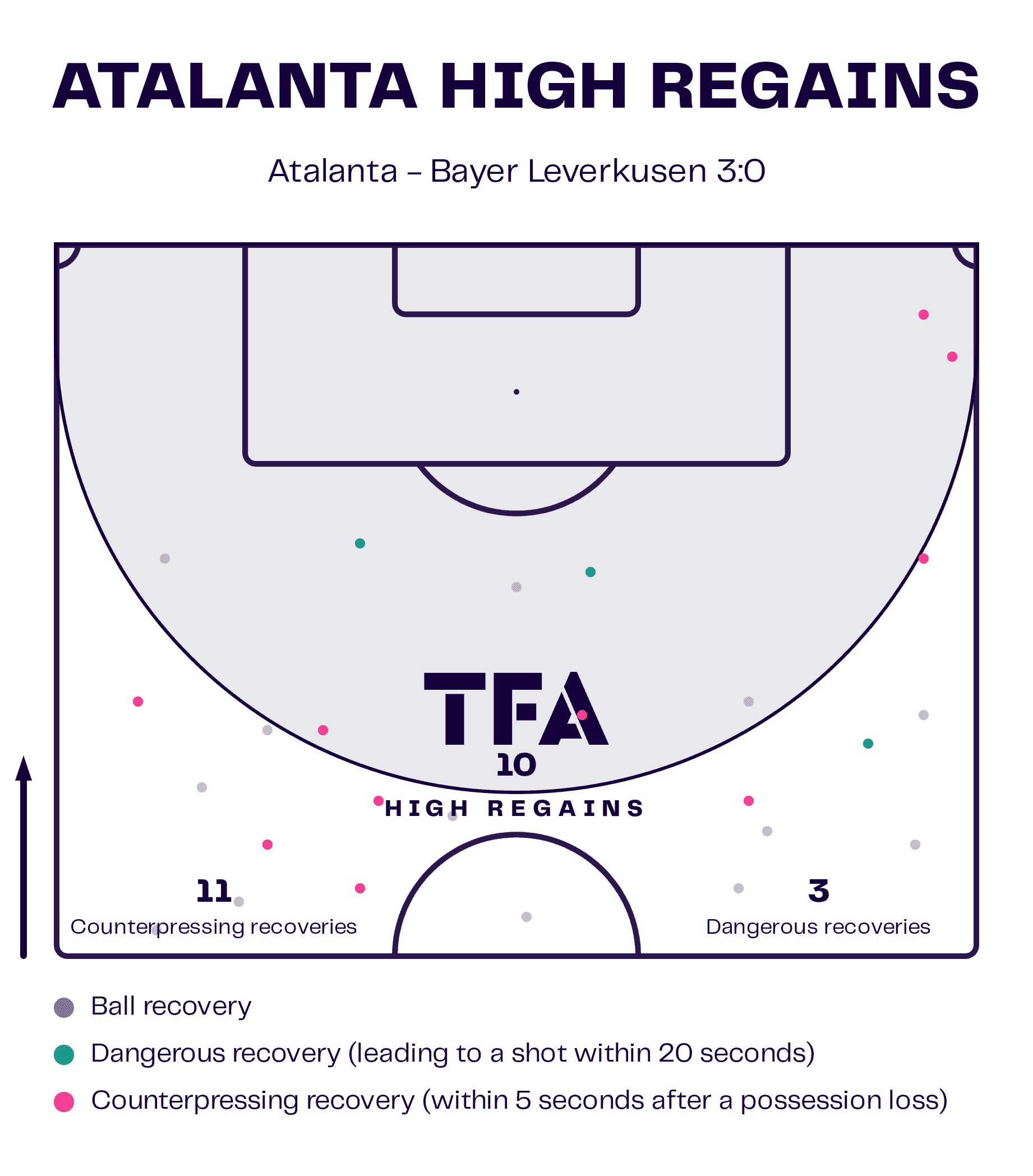
The contrast in preparation and familiarity with this type of match was stark.
While Leverkusen had played many competitive games, none had been against a team like Atalanta, which made the final a uniquely challenging experience.
Atalanta’s ability to force the game into their preferred style ultimately proved too much for Leverkusen, who found themselves outmatched and unable to effectively execute their build-up play under the immense pressure.
The second goal for Atalanta epitomised their effective defensive strategy.
Leverkusen’s failure to break free from Atalanta’s relentless man-to-man pressure resulted in a turnover, allowing players like Ademola Lookman to exploit their pace and technical ability in direct counter-attacks.
These swift transitions after regaining possession from Leverkusen’s errors were a hallmark of Atalanta’s game plan.
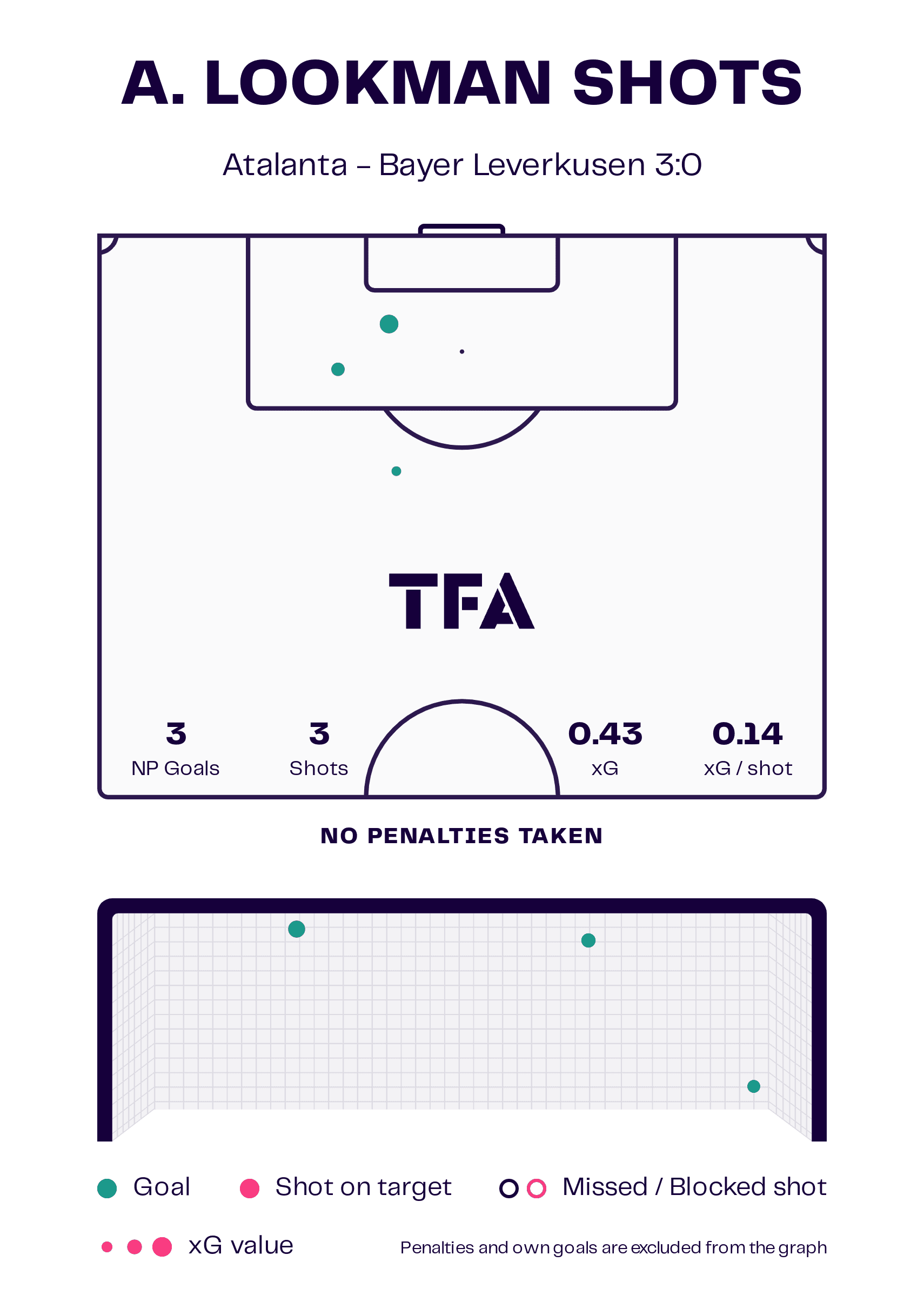
Why the Game Plan worked out
Atalanta’s game plan proved highly effective against a possession-based side like Bayer Leverkusen in the UEFA Europa League final due to several key factors.
From the outset, Atalanta’s aggressive man-to-man marking and high-pressing tactics disrupted Leverkusen’s rhythm and momentum, which are crucial for a possession-based team to build their play.
Despite Leverkusen’s ability to progress into higher spaces after conceding two early goals, they struggled to create asymmetry or overloads.
This was largely due to Atalanta’s well-executed mid-block press, which denied Leverkusen the time and space needed to develop their typical pass-and-move sequences.
Atalanta’s midfielders and wide players were particularly effective at covering passing lanes and slowing down Leverkusen’s build-up, preventing them from gaining any real foothold in the game.
Atalanta’s defensive strategy was designed to frustrate Leverkusen’s possession game.
They were exceptionally aggressive in the midfield and wide areas, ensuring that Leverkusen rarely managed to push them deep into their own half.
This constant pressure forced Leverkusen into making hurried decisions, often resulting in turnovers or ineffective passes.
Whenever Leverkusen did manage to find small gaps to break through Atalanta’s lines, they were immediately met with tactical fouls that disrupted their flow and prevented them from building any sustained momentum.
This game dynamic was reminiscent of Atalanta’s previous matches against possession-based teams like Liverpool.
Atalanta employed a similar strategy, successfully creating the same disruptive game picture.
Teams like Atalanta, which thrive on high pressing and aggressive midfield play, often perform better against possession-oriented opponents who rely on rhythm and tempo to control the game.
Another crucial aspect of Atalanta’s success was their ability to manage and control the tempo of the game.
By constantly pressing and breaking up Leverkusen’s play, Atalanta prevented them from settling into their usual passing rhythm.
This forced Leverkusen to rely on quick pass-and-move actions, which were effectively covered and slowed down by Atalanta’s disciplined defence.
From a statistical perspective, Atalanta’s game plan also highlighted some interesting trends.
Despite Leverkusen’s high xG (expected goals) in many of their matches this season, Atalanta managed to keep their xG below 1 in this crucial final.
This was partly due to Atalanta’s ability to force Leverkusen into taking low-quality shots under pressure.
Furthermore, Leverkusen’s tendency to score late goals and outscore their xG throughout the season meant that it was statistically likely that they would eventually face a match where these late goals would not materialise.
The final against Atalanta turned out to be that match, as the Italian side’s disciplined and aggressive approach neutralised Leverkusen’s offensive threat.
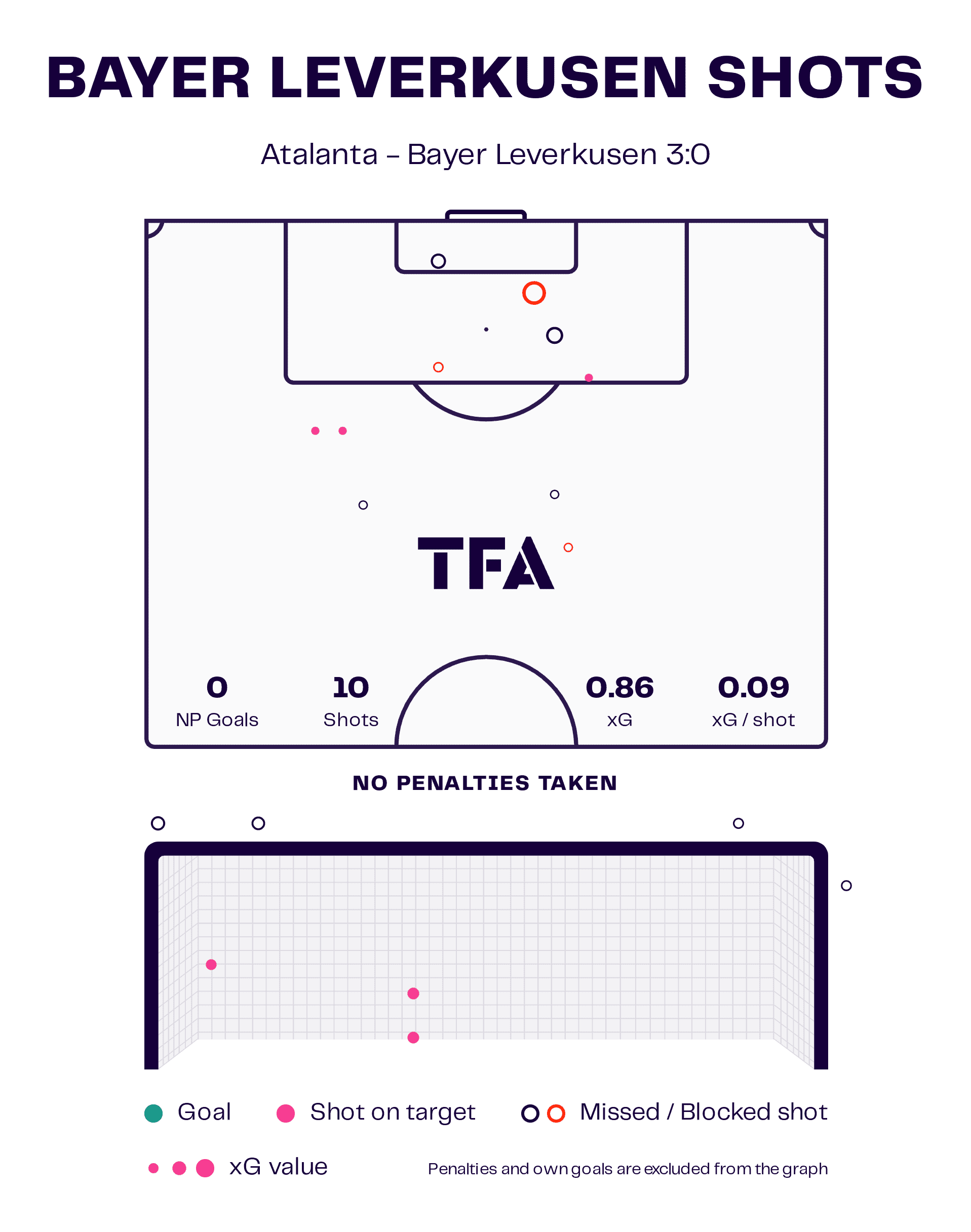
For teams planning to face Atalanta in the future, a practical strategy could involve two distinct approaches.
One approach is to play with rigidity, minimising risks, and focusing on creating 1v1 situations out wide while conceding possession to Atalanta.
The alternative is to embrace a more dynamic, relational playstyle, aiming to generate as many chaotic scenarios as possible.
Initially, Leverkusen’s emphasis on central play actually worked to Atalanta’s advantage, allowing them to capitalise on turnovers from Leverkusen’s midfielders and launch high-quality counterattacks.
Shifting the focus to the wings tends to be a safer option, a strategy that teams like Manchester City and Arsenal have mastered.
Conclusion
The UEFA Europa League final of 2024 between Atalanta BC and Bayer Leverkusen concluded with a resounding 3-0 victory for Atalanta, marking a historic achievement for the Italian side.
Atalanta’s game plan, rooted in aggressive man-to-man defending and strategic counterattacks, proved highly effective against Leverkusen’s possession-based style.
Despite Leverkusen’s impressive unbeaten run and tactical prowess, they struggled to cope with Atalanta’s relentless pressure and incisive play.
The match highlighted Atalanta’s ability to exploit turnovers and transition swiftly from defence to attack, creating high-quality chances that Leverkusen could not match.
Leverkusen’s attempts to control the game through central play backfired, as Atalanta’s midfielders and defenders successfully disrupted their rhythm and capitalised on mistakes.
Atalanta’s tactical acumen, physical intensity, and clinical finishing secured their first major trophy in 61 years.

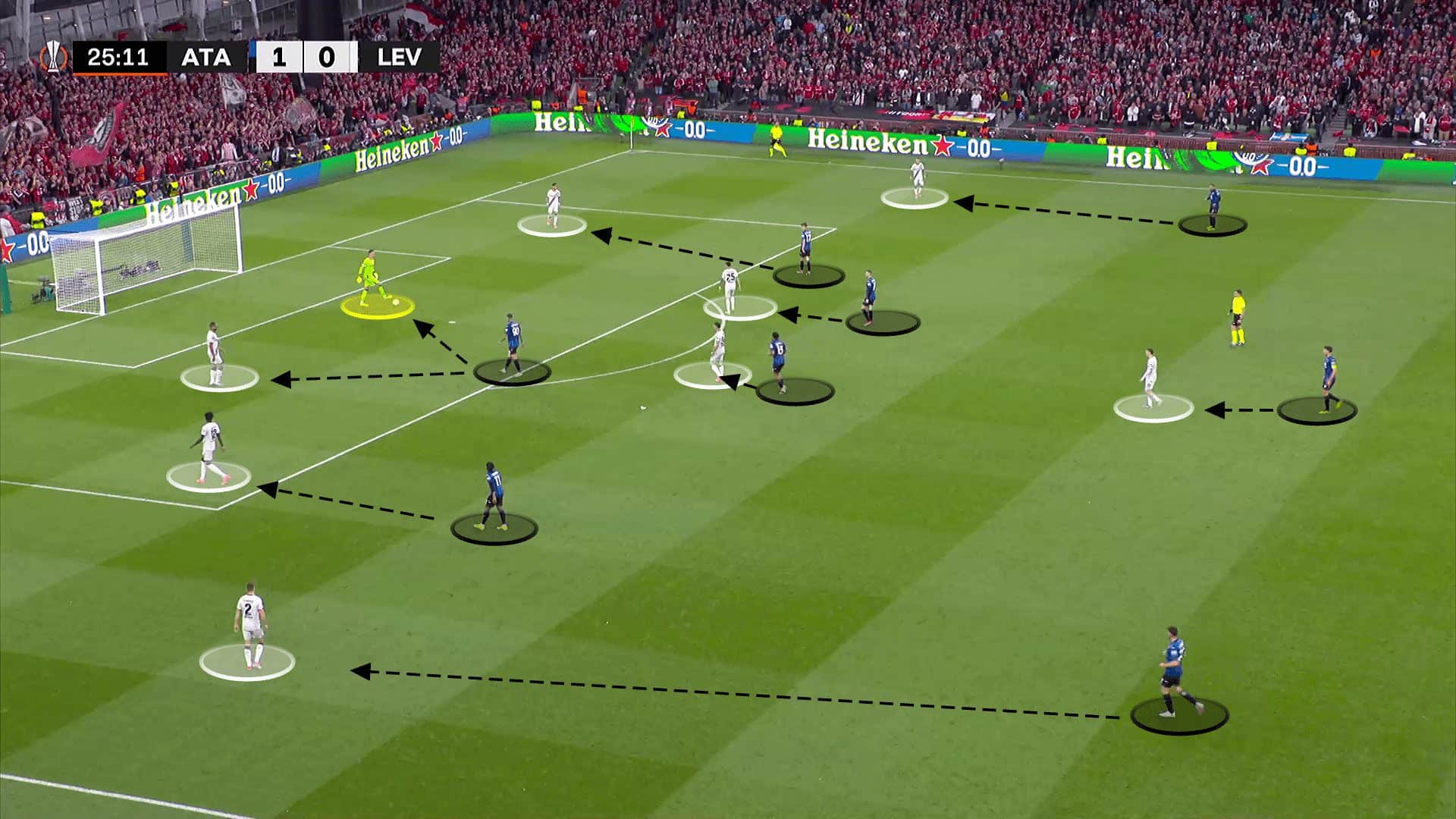



Comments